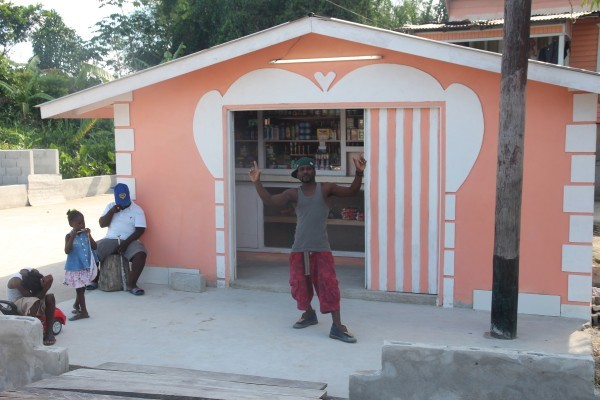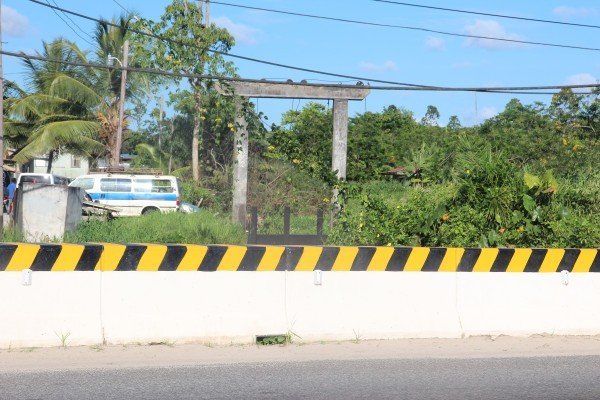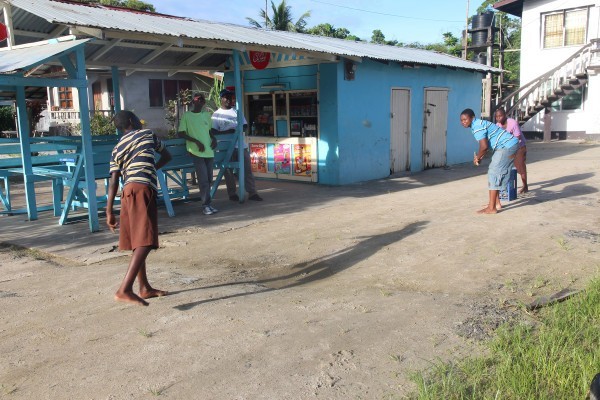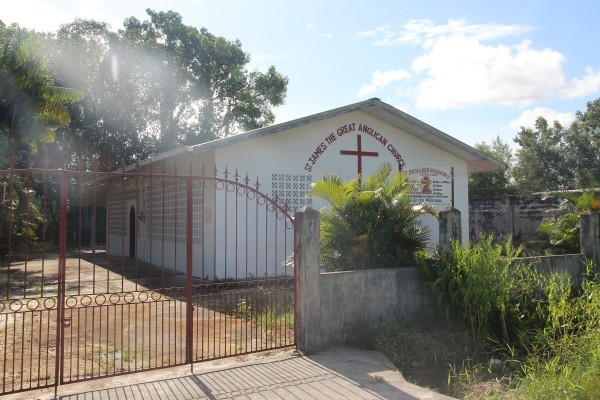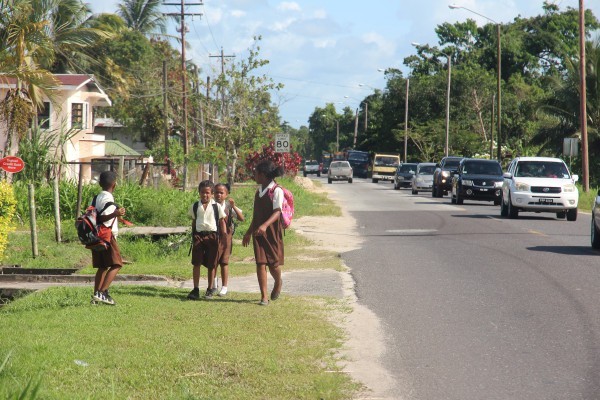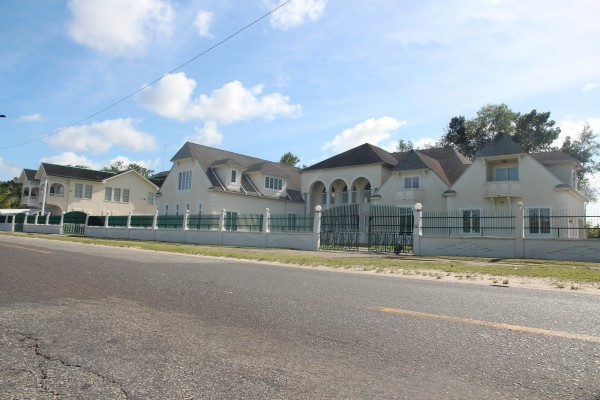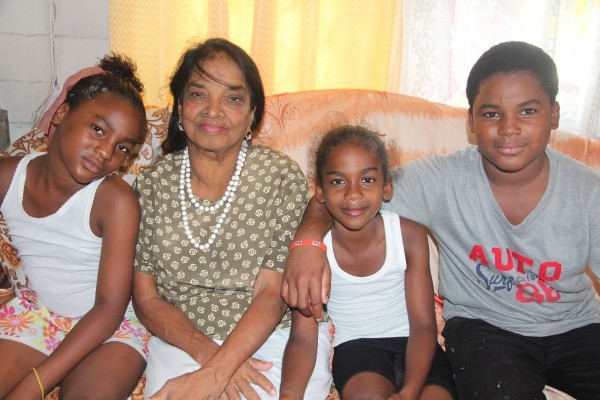Story and photos by Joanna Dhanraj
Amid towering coconut and other palms and many other beautiful trees is a tiny village called Relief, nestled between villages also with odd names such as Support and Land of Canaan. Relief is home to approximately 350 persons, most of whom are related.
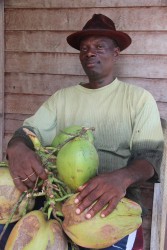
remaining coconuts from
a cluster he harvested
One charming resident tells her story of coming to Relief.
In 1950, four-year-old Shirley Sookram arrived in Relief with her parents and six-year-old sister, Leonie Barran. Shirley is the second of nine sisters (no brother) who grew up in Relief. When she first arrived, the East Bank Demerara public road was “red loam,” she said.
She reminisces a time when she, her sisters and friends played among the tiny mangroves (now gigantic trees) on the dam by the river, swam in a nearby trench (now filled up with trees) and wallowed in the mud for crabs to take home to cook.
“We used to paddle boat to Wales on the West Bank to sell at the market with our parents. We sold chickens and ground provisions. At the age of 6-8 years old we worked with our grandfather and grandmother in the farm [at Relief] after school. My grandmother would often catch fish from a pond in the back dam. She cooked the bigger ones and gave me the smaller ones. I kept them as pets in a smaller pond behind us,” said an excited Shirley.
“In our days everyone was referred to as cousin [eg Cousin Shirley] whether they be family or friends, our age or older,” she recalled.
Sookram was once an Office Attendant at the Caricom Secretariat when it was located on the third and fourth floors of the Bank of Guyana and would have worked under the leadership of the current first lady, Sandra Granger. She said that although that was over 30 years ago when society didn’t see the need for a woman to work, her family and friends had always supported her. Sookram said her village is free from crime and is quiet and pleasant.
A few houses away is farmer Joseph Harmon who took up residence in Relief in 1975 when he was 15 years old. He recalls a place filled with bushes and no street lights. Harmon said that in those days the village had a more homely atmosphere to now. He reminisces playing “war-break” and games of catch with friends.
Harmon farms three miles down in the backdam. He plants ground provision (cassava, eddo), plantain and fruits and vegetables for himself and family mainly but would sell if there’s a surplus. Harmon said business is a bit slow because of the weather since the clogged drains often cause flooding. His yard shows off the prominent farmer he is with its coconuts and many fruit trees from the front of the yard leading all the way to the back. The enthusiastic Harmon says Relief has produced doctors, farmers, lawyers, teachers and a few entrepreneurs. He echoes Shirley Sookram about the quiet and peaceful environment Relief is.
After visiting with Harmon, ‘The world beyond Georgetown.’ caught up with a pleasant and modest shopkeeper, Donette Scott, who has lived at Relief all her life (for over 40 years). Her little shop seemed packed to the brim and its surroundings were spotless. According to her, business is a bit slow but she has her faithful customers. Scott said that though there are a few shops in the village many persons journey the 30-minute drive to Georgetown for groceries. She said they once had a farm that was kept clean and efficient during the late Forbes Burnham government, but now it’s overrun and a jungle. Apart from drainage she called for a playground since the youths need somewhere to socialize.
According to her, there were once plans to have one and these were spearheaded by the now deceased Nyron Merza, a pilot who died in a plane crash 24 years ago. He was once a resident of Relief and had started clearing a spot of land to fulfil his dream, and that of the villagers, for a playground but because of the unfortunate incident it was left unfinished.
For Scott, back in the days the village was different because villagers were more disciplined and they reached out more to one another. Both of these attributes are still there, she said, but are not as prevalent as before.
Meanwhile, Donna Williams, Scott’s sister-in-law who lives in the same yard, is a teacher at the Supply Primary School.
Supply Primary is the lone school in the village. It sounds awkward, but then it was revealed that Relief was once a part of Supply. In fact it is still called Supply by some.
It was only a few years ago that Supply was divided into three villages: Supply, Support and Relief. Many bus drivers still don’t know where Relief is, since most of them refer to the village as Supply.
Williams, who hails from another village, has been living in Relief for 14 years. She highlighted some of the issues that need addressing. “We need a new school. It is a really old school [it is more than 40 years old] and it’s lacking space. Although the ministry did some renovation recently to a part of the school, it’s time we have a new school,” she said. Although there’s a primary school for the elementary children, there’s no secondary school and the students travel every day to their respective schools in Diamond, Friendship, Soesdyke and even to Georgetown, while the nursery-age children attend school two villages away. It is her wish also to have a recreational facility so their youths could be catered for.
For all of the villagers who agreed to speak with the World Beyond Georgetown, Relief is more than the name of their home village, it’s also what they feel when they’re home, basking in the peace and tranquillity afforded there.


